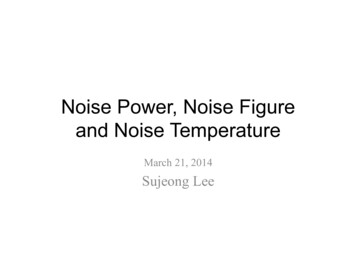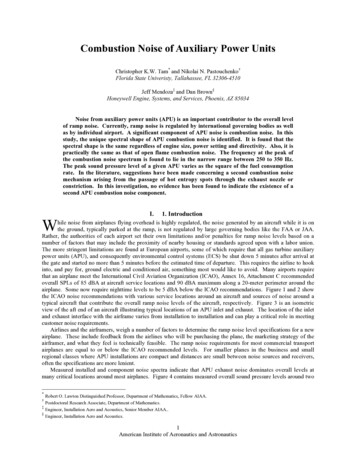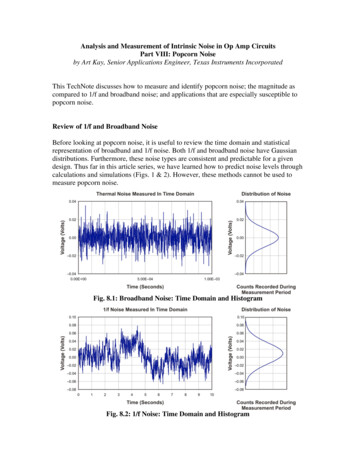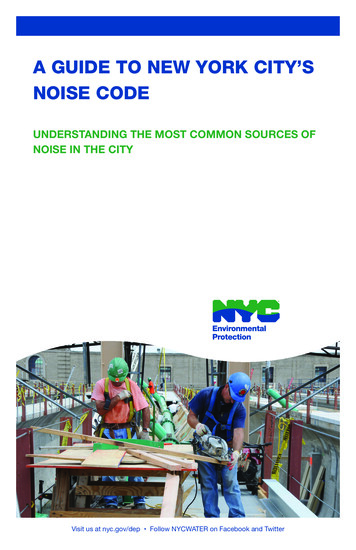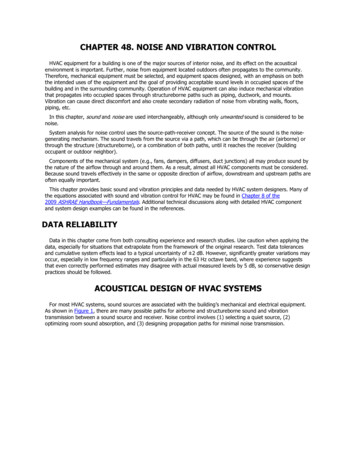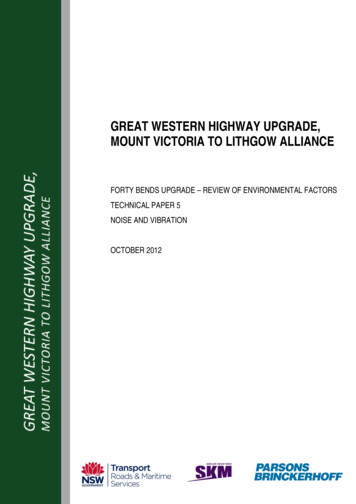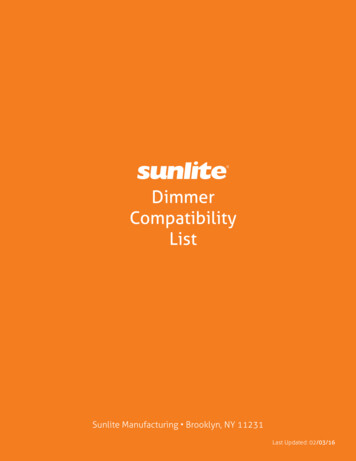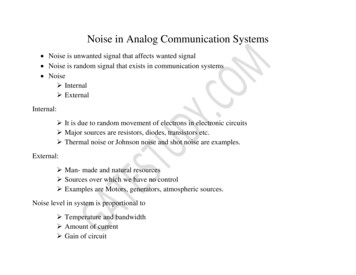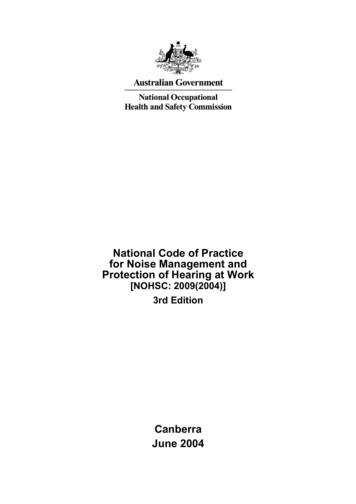
Transcription
National Code of Practicefor Noise Management andProtection of Hearing at Work[NOHSC: 2009(2004)]3rd EditionCanberraJune 2004
National Occupational Health and Safety CommissionNational Code of Practicefor Noise Management andProtection of Hearing at Work[NOHSC: 2009(2004)]3rd EditionCanberraJune 2004
Commonwealth of Australia 2004ISBN 1 920763 33 3This work is copyright. You may download, display, print and reproduce this materialin unaltered form only (retaining this notice) for your personal, non-commercial use oruse within your organisation. Apart from any use as permitted under the CopyrightAct 1968, all other rights are reserved. Requests for further authorisation should bedirected to the Commonwealth Copyright Administration, Intellectual PropertyBranch, Department of Communications, Information Technology and the Arts, GPOBox 2154, Canberra ACT 2601 or posted at http://www.dcita.gov.au/cca.
FOREWORDIn seeking to achieve Australian workplaces free from death, injury and disease theNational Occupational Health and Safety Commission (NOHSC) works to lead andcoordinate national efforts to prevent workplace death, injury and disease.We seek to achieve our mission through the quality and relevance of information weprovide and to influence the activities of all parties with roles in improving Australia’sOHS performance.NOHSC has identified five national priorities to achieve the vision: reduce high incidence/severity risks; strengthen the capacity of business operators and workers to understand andmanage OHS effectively; prevent occupational disease more effectively; eliminate hazards at the design stage; and strengthen the capacity of government to influence OHS outcomes.This publication is a contribution to achieving those objectives.iii
iv
COPE14.DEFINITIONS25.IMPLEMENTING THE CODE6ObjectivesStrategiesConsultationProvision Of InformationResponsibilities Of EmployersResponsibilities Of EmployeesResponsibilities Of Self-Employed PersonsResponsibilities Of Manufacturers, Importers And Suppliers Of PlantFor Use In Workplaces6667788NOISE CONTROL PLANNING9PolicyProgram Of Action996.7.8.9.10.11.8NOISE IDENTIFICATION AND ASSESSMENT11Noise IdentificationNoise AssessmentObjectivesHow To Carry Out A Noise AssessmentInstruments1111121212ENGINEERING NOISE CONTROL MEASURES14New Plant And WorkplacesExisting Plant And WorkplacesEngineering Treatment Of The SourceEngineering Treatment Of The Noise Transmission PathFurther Guidance1414141617ADMINISTRATIVE NOISE CONTROL MEASURES18Further Information18PERSONAL HEARING PROTECTORS19Hearing Protector AreasSelection Of Personal Hearing ProtectorsInspection And MaintenanceTraining And Supervision19192021TRAINING22Training ObjectivesProgram Content2222v
12.AUDIOMETRIC TESTING24PurposeTesting SchemeAssessment Of AudiogramsAction To Be Taken When Threshold Shift DetectedUpdating Of Reference AudiogramsRecords242424252525APPENDIX 1. Guidance Material For Manufacturers, Importers AndSuppliers On The Presentation Of Information About Noise LevelsGenerated By Plant26APPENDIX 2. Noise Hazard Identification Checklist30APPENDIX 3. Hearing Protector Classification32REFERENCED DOCUMENTS33vi
PREFACEOccupational noise-induced hearing loss (NIHL) is a major compensable industrial disease inAustralia and entails substantial economic costs. Exposure to excessive noise also entailslargely unrecognised costs to organisations by way of increased employee turnover andabsenteeism, lowered performance and possible contribution to accidents. As well as theeconomic cost for employers, NIHL imposes a severe burden on health and social servicesand the Australian economy as a whole.To the individual affected, the social handicaps of NIHL are also severe. NIHL is irreversibleand leads to communication difficulties, impairment of interpersonal relationships, socialisolation and a very real degradation in the quality of life. The family and others close to theaffected person often experience secondary consequences of the condition. Hearing aidsmay be of benefit in overcoming some of the problems of NIHL but normal hearing can neverbe fully restored. Of those people affected, 20 per cent or more also suffer from tinnitus(ringing in the ears), in some cases to a severe degree.The National Occupational Health and Safety Commission (NOHSC) is concerned aboutnoise-induced hearing loss as a major occupational disease. In December 1988, NOHSCendorsed its strategy for the prevention of NIHL1 and followed this up with the developmentof a national standard and code of practice. Drafts of these documents were released forpublic comment in November 1989. Having considered public comment on the draftdocument, NOHSC declared the National Standard for Occupational Noise [NOHSC:1007(1993)] and the National Code of Practice for Noise Management and Protection ofHearing at Work [NOHSC: 2009(1993)] in March 1992.In 2000, NOHSC amended the national standard and code of practice to update themeasurement of peak noise from an unweighted (linear) peak sound pressure level, Lpeak, toa C-weighted peak sound pressure level, LC,peak. C-weighting measurement is a morereliable form of measurement when compared to the linear response to impulse noise. Thelatter may vary according to different sound measuring instruments.The national standard for exposure to noise in the occupational environment is an averagedaily exposure level of 85 decibels. This is consistent with overwhelming scientific evidencewhich indicates that exposure levels above 85 decibels represent an unacceptable risk to thehearing of those exposed. Many other developed countries have introduced legislationbased on this standard. For peak noise, the national standard is a peak sound pressurelevel of 140 decibels.In 2004, NOHSC revised the National Code of Practice for Noise Management andProtection of Hearing at Work to achieve consistency with national best practice. Thenational code of practice provides practical guidance on how the national standard can beachieved and is intended to assist employers, employees, unions, management, health andsafety committee representatives, safety officers, occupational health and safetyprofessionals and others requiring guidance on understanding and reducing exposure toworkplace noise.The levels specified in the national standard are the maximum acceptable exposure levelsfor noise in the workplace. However, over long periods, repeated exposure to noise between75 and 85 decibels may be a small risk to some people. With progressively increasinglevels, the risk becomes greater. Workplace noise levels lower than 85 decibels are,therefore, desirable, if practicable.1National Occupational Health and Safety Commission, National Strategy for the Prevention of Occupational Noise-inducedHearing Loss [NOHSC:4004(1989)], Australian Government Publishing Service, Canberra, 1989.vii
viii
1. TITLE1.1This national code of practice may be cited as the National Code of Practicefor Noise Management and Protection of Hearing at Work [NOHSC: 2009(2004)], 3rdEdition.2. PURPOSE2.1This National Code of Practice for Noise Management and Protection ofHearing at Work [NOHSC:2009(2004)] provides practical guidance on how theNational Standard for Occupational Noise [NOHSC:1007(2000)] can be achieved.3. SCOPE3.1This National Code of Practice for Noise Management and Protection ofHearing at Work [NOHSC:2009(2004)] applies to all workplaces where there ispotential for exposure to excessive noise, the plant and processes in thoseworkplaces, and all persons in those workplaces (consistent with relevantState/Territory legislation) with potential for exposure to excessive noise.1
4. DEFINITIONS4.1In this National Code of Practice for Noise Management and Protection ofHearing at Work [NOHSC:2009(2004)]:Acoustic (or acoustical) means containing, producing, arising from, actuated by,related to, or associated with, sound.Acoustic calibrator means a device for applying a sound pressure of known level tothe microphone of a sound measuring system, for the purpose of calibration.Administrative noise control measures are work systems designed to substantiallyreduce exposure to noise, including the time exposed to noise and the time at whichnoise is produced. Examples are job redesign or rosters which are designed toreduce exposure to noise. Engineering noise control measures and the use ofpersonal hearing protectors are not included.Attenuation means a reduction in the magnitude of sound.Audiogram means a chart or table relating a person's hearing threshold levels forpure tones to frequency.Audiometric test (or testing) means the measurement of the hearing thresholdlevels of a person by means of monaural pure tone air conduction threshold tests.A-weighting refers to a standardised frequency response used in sound measuringinstruments as specified in Australian Standard AS 1259.11.Note: Historically it was developed to model the human ear response at low soundlevels. However A-weighting is now frequently specified for measuring soundsirrespective of level and studies have shown a relationship between the long-termexposure to A-weighted sound pressure levels and hearing damage risk.C-weighting refers to a standardised frequency response used in sound measuringinstruments, specified in Australian Standard AS 1259.11.Note: Historically it was developed to model the human ear response at high soundlevels. It is now used to measure peak noise levels.Competent person, in the context of supplying information on noise levelsgenerated by plant, means a person whom the manufacturer or supplier ensures hasacquired knowledge and skills, through a combination of training, education andexperience, enabling that person to correctly perform a specified task.Consultation means the sharing of information and exchange of views betweenemployers, employees and/or employee representative(s) on health and safetyissues. It includes the opportunity to contribute to decision making in a timely fashionto minimise the risk(s) of exposure to excessive noise.Daily noise exposure level see definition for ‘LAeq,8h’.dB means the abbreviation for decibel. Also see definition for decibel.dB(A) means A-weighted sound pressure level in decibels. Also see definition forA-weighting.2
dB(C) means C-weighted sound pressure level in decibels. Also see definition forC-weighting.Decibel is the unit used to indicate the relative magnitude of sound pressure leveland other acoustical quantities. The range of sound pressures commonlyencountered is very large so a logarithmic scale is used. The decibel is the unit usedon this scale and is abbreviated to 'dB'. On the decibel scale, the threshold ofhearing occurs at a sound pressure level of about 0 dB and the threshold of painoccurs at about 120 dB. As the decibel is also used to describe the level of otherquantities, such as sound power and vibration acceleration, it is always necessary torefer to the specific quantity being measured, for example, LAeq,8h or LC,peak.Employee means an individual who works under a contract of employment,apprenticeship or traineeship.Employee representative(s) includes an employee member of a health and safetycommittee where established in the workplace, or a person elected to represent agroup of employees on health and safety matters.Employer means a corporation or an individual who employs persons under contractof employment, apprenticeship or traineeship.Note: The definition of employer includes the self-employed, which means a personwho works for gain, other than under a contract of employment, apprenticeship ortraineeship, whether or not that person employs others.Engineering noise control measures means any engineering procedure thatreduces the sound level either at the source of the noise or in its transmission, butdoes not include the use of administrative noise control measures or personalhearing protectors.Excessive noise means noise that exceeds those levels defined in the NationalStandard for Occupational Noise [NOHSC:1007(2000)].Hazard means anything that may result in harm to the hearing of a person.Hearing protector areas means areas where persons may be exposed to excessivenoise. During normal operations, no person should enter such an area withoutwearing appropriate personal hearing protectors. Hearing protector areas should beclearly defined and sign-posted according to Australian Standard AS 13192.Impulse sound means sound consisting of a single pressure peak, or a sequence ofsuch peaks, or a single burst with multiple pressure peaks whose amplitude decayswith time, or a sequence of such bursts.Integrating/averaging sound level meter (ISLM) means a sound level meterequipped with an integrating function which enables the meter to process acontinuous, variable, intermittent or impulsive sound to give a single, integrated levelor Leq for the sampling period.LAeq,8h(eight-hour equivalent continuous A-weighted sound pressure level in dB(A)referenced to 20 micropascals) means that steady noise level which would, in thecourse of an eight-hour period, cause the same A-weighted sound energy as thatdue to the actual noise over an actual working day. LAeq,8h is to be determined inaccordance with Part 1 of Australian/New Zealand Standard AS/NZS 12693.LC,peak (peak noise level) means C-weighted peak sound pressure level in decibels(dB(C)) referenced to 20 micropascals determined in accordance with. Part 1 ofAustralian/New Zealand Standard AS/NZS 12693.3
Noise means any unwanted or damaging sound.Noise control policy means a written policy, developed by the employer, inconsultation with employees and/or employee representative(s) that should aim tominimize the generation and emission of noise from plant and/or processes and setgoals for exposure to peak and daily noise exposure levels at work and strategies toachieve them.Occupational noise-induced hearing loss means hearing impairment arising fromexposure to excessive noise at work. Occupational noise-induced hearing loss isalso commonly known as industrial deafness.Octave band analysis means analysis of the frequency content of noise into octavebands.Octave band filter means a filter that attenuates all noise except that falling betweentwo frequencies an octave apart. Octave band filters are used to measure whichfrequencies are present in a given noise.Peak noise level see definition for LC,peak.Personal hearing protection program means a program for personal hearingprotection and, where required, regular hearing testing, which is adopted wheretechnical or economic problems delay, or make impracticable, the reduction ofexposure to excessive noise by engineering or administrative noise controlmeasures.Personal hearing protectors means a device, or pair of devices, worn by a personor inserted in the ears of a person to protect the person's hearing.Plant means any machinery, equipment, appliance, implement or tool, and anythingfitted or connected to them.Practicable means 'practicable' in Victoria, Queensland, Western Australia and theNorthern Territory, 'reasonably practicable' in New South Wales, South Australia, theAustralian Capital Territory and Commonwealth jurisdiction, and a 'reasonableprecaution' in Tasmania.Reverberation means the persistence, by echo or reflection, of sound in anenclosure after the emission by the source has stopped.Risk means the probability of harm occurring to the hearing of a person.Sound means small fluctuations in the air pressure that result in a wave capable ofexciting in a listener the sensation of hearing.Sound exposure meter (SEM), or noise dosemeter, means an instrument formeasuring a person’s daily noise exposure level by automatically integrating soundenergy over a measurement period. The person concerned wears the instrument.Sound level meter (SLM) means an instrument consisting of a microphone, amplifierand indicating device, having a declared performance, and designed to measure afrequency-weighted and time-weighted value of the sound pressure level.Sound power means the total sound energy radiated per unit time. The standardunits are watts (W).Sound power level means the relative magnitude of sound power, customarilyexpressed in decibels referenced to 1 picowatt.4
Sound pressure means the varying component of the pressure at a point in a soundfield. The standard units are pascals (Pa).Sound pressure level (SPL) means the relative magnitude of sound pressure,customarily expressed in decibels referenced to 20 micropascals.Tinnitus means ringing or other noises in the head or ears that can be caused byexposure to excessive noise. Tinnitus can become permanent and when severe maydisrupt sleep, reduce concentration and lead to irritability and depression. Tinnitusmay lead to increased absenteeism and decreased productivity. It can also affectgeneral job satisfaction and contribute to adverse health effects, such as, stress.Tonal noise means noise that produces in a listener a definite pitch sensation.Workplace means any place, whether or not in an aircraft, ship, vehicle, building orother structure, where employees or self-employed persons work, or are likely to bein the course of their work.5
5. IMPLEMENTING THE CODE5.1This National Code of Practice for Noise Management and Protection ofHearing at Work [NOHSC: 2009(2004)] provides a framework for the management ofexposure to noise at work and for minimising the risk of the effects of such exposure.It also provides guidance, which will assist employers and employees to understandand conform to the National Standard for Occupational Noise [NOHSC: 1007(2000)].OBJECTIVES5.2The objectives of this national code of practice are to:(a)minimise occupational noise-induced hearing loss and tinnitus by an approachthat emphasises the reduction of noise levels at work by engineering noisecontrol measures;(b)promote the recognition and understanding of the effects of exposure to noise;(c)promote the adoption of a systematic approach to reducing and managingexposure to excessive noise; and(d)promote implementation through consultation between employers, employeesand/or employee representatives.STRATEGIES5.3The most effective way of controlling exposure to workplace noise is throughthe reduction of noise at its source.5.4A comprehensive approach using hazard identification, risk assessment andrisk control should be adopted to effectively manage the risk of noise-inducedhearing loss and other noise-related health effects. Measures could includeequipment and job redesign and training.CONSULTATION5.5Consultation and cooperation between employers, employees and employeerepresentative(s) and the free exchange of information pertaining to health andsafety, are essential to the effective implementation of this national code of practice.5.6This national code of practice should be implemented by employers inconsultation with employees and employee representative(s). This defines theconsultation process referred to throughout the document.5.7Where they exist, occupational health and safety committees orrepresentatives should review all existing processes involving exposure to excessivenoise, and participate in the development of systematic programs of equipment andjob redesign. The introduction of changes in the workplace or in job design shouldonly occur following full consultation with employees and employee representative(s)through consultative processes.6
PROVISION OF INFORMATION5.8Information should be provided by the employer taking language and literacyinto account, to familiarise employees with:(a)(b)(c)(d)(e)(f)(g)(h)(i)(j)what noise is;the effects of noise on hearing;the social handicaps of noise-induced hearing loss and tinnitus;the exposures to noise in their particular workplace;the reasons for, and nature of, the general noise control measures which areused to protect them and other persons who might be affected by their work;the specific control measures which are necessary in relation to eachemployee's own job (these measures may include instruction in the correctuse and maintenance of noise control equipment and correct methods ofoperation for minimising noise levels);the noise control policy and program of action and timetable for futureimprovements;the arrangements for reporting plant or process defects which are likely tocause excessive noise;when and how to use personal hearing protectors provided and their propercare and maintenance; andstatutory responsibilities of employers, employees and self-employed persons.RESPONSIBILITIES OF EMPLOYERS5.9The prime responsibility for ensuring that a safe working environment isestablished, and safe work practices are implemented and maintained, resides withthe employer. Employers should ensure that:(a)(b)(c)(d)(e)(f)(g)statutory requirements are complied with;a noise control policy and program of action are developed and implemented;all levels of management and employees are aware of the control measures toreduce exposure to noise;all employees and contractors are encouraged to cooperate in using agreedsafe work practices;information on noise, the risks of exposure to noise and the appropriatecontrol measures are disseminated in a manner appropriate to the workplace;a comprehensive personal hearing protection program, including the selectionof personal hearing protectors, and instruction of employees in their correctuse and maintenance, is implemented; andemployees receive appropriate training when it is required.5.10 Employers should recognise the role of the supervisor in the management ofnoise and the protection of hearing at work and there should be close liaisonbetween supervisors and employees.7
RESPONSIBILITIES OF EMPLOYEES5.11 Employees should comply with all statutory requirements and establishedworkplace procedures and cooperate in all activities that have as their objective theprotection of hearing at work and the minimisation of occupational noise-inducedhearing loss.RESPONSIBILITIES OF SELF-EMPLOYED PERSONS5.12 Employers and self-employed people should take reasonable care to ensuretheir own safety and health in relation to workplace noise and avoid adverselyaffecting the hearing or safety and health of others who may be affected by theiroperations.RESPONSIBILITIES OF MANUFACTURERS, IMPORTERS AND SUPPLIERS OFPLANT FOR USE IN A WORKPLACE5.13 Manufacturers, importers and suppliers should ensure that plant is designedand constructed so that its noise emission is as low as practicable when properlyinstalled and used. Where necessary, research and development work should becarried out to reduce noise emission.5.14 In deciding whether plant is likely to be noisy enough to require considerationof noise reduction, it will be necessary to take into account the range of uses forwhich it is sold, available information on the conditions under which it is likely to beused and the foreseeable methods of using it.5.15 If operation of the plant is likely to create a noise hazard, the manufacturer,importer or supplier should ensure that adequate information is made available to theemployer, if possible prior to the supply of the plant, about:(a)(b)its noise emission; andthe means of installation, maintenance and use of the plant that will enable itto generate the lowest practicable noise levels.5.16 Guidance for manufacturers, importers and suppliers on the presentation ofinformation for noise levels generated by plant is provided in Appendix 1.8
6. NOISE CONTROL PLANNING6.1Where excessive noise may exist the employer, in consultation withemployees and employee representative(s), should develop a written noise controlpolicy and program of action to implement noise control and manage exposure tonoise. Copies of the policy and program of action should be available to allemployees and employee representative(s) on request, and form a basic part of theinformation, induction and training activities.POLICY6.2A noise control policy should aim to minimise the generation and emission ofnoise from plant and/or processes and set goals for exposure to peak and daily noiseexposure levels at work and strategies to achieve them.6.3The policy should be reviewed at appropriate intervals and updated asnecessary.6.4A noise control policy should cover the following issues, where they areapplicable to the workplace concerned:(a)(b)(c)(d)(e)(f)(g)(h)goals for minimising daily noise exposure levels and peak noise levels inexisting work areas;design goals for new work areas (both for the building and plant);the selection and purchase of quiet plant;noise controls to be used in temporary work areas and situations;agreements with contractors in terms of responsibilities for noise control andprovision of information on noisy processes;audiometric testing and availability of records;the funding for the noise control program; andthe period of review of the noise control program.PROGRAM OF ACTION6.5The specific steps in the program of action should be implemented in agreedtimeframes. Steps should include the following:(a)(b)(c)(d)(e)(f)(g)(h)assign a member of management to have overall responsibility forimplementing and monitoring the program;conduct a preliminary noise hazard identification check to determine whetherproblems with exposure to noise are likely to exist;decide the type and detail of the noise assessments needed to be carried out,the period between them and the persons carrying them out;develop a program for the selection of new or replacement plant that canminimise exposure to noise;decide whether or not engineering noise control measures are practicable andthe priorities to be given to different noisy situations;decide on suitable administrative noise control measures;select, provide and maintain suitable personal hearing protectors;identify, with the use of appropriate signs, hearing protector areas;9
(i)(j)(k)provide on-going training to employees;provide voluntary audiometric testing;develop monitoring procedures which should include the following:(i)(ii)(iii)(iv)(l)(m)10check that measures used to control noise levels, such as silencers orenclosures, are maintained in good order and in position during theoperation of noisy machines,check, where necessary, the noise level to ensure that hidden defectsare not causing high exposure to noise,monitor the use of personal hearing protectors, andcheck that personal hearing protectors are maintained in goodcondition.maintain relevant records and make them available to all employees andemployee representative(s) on request. (The records should be kept in a formeasily understood by those likely to be exposed); andprovide for periodic management review.
7. NOISE IDENTIFICATION AND ASSESSMENTNOISE IDENTIFICATION7.1Identification of noise hazards in a workplace enables people who may beexposed to excessive noise to be identified so that their exposures can be assessed.It also enables situations where immediate control measures are possible to berecognised and acted on and provides information for the person carrying out thedetailed assessment.7.2No special skills are needed to conduct noise identification, but it should bedone in consultation with those who understand the work processes, affectedemployees and/or their employee representative(s). One way is to conduct awalkthrough of the workplace, identifying noisy processes and tasks. As an informalguide, when a raised voice is needed to communicate with someone about onemetre away, a workplace noise assessment is needed. Other information can begathered from plant manufacturers and suppliers (see Appendix 1).7.3A noise identification checklist is provided in Appendix 2 to help with theprocess.7.4When no prior information is available a noise assessment should be made toestablish if exposure to noise is acceptable or not.NOISE ASSESSMENT7.5All workplaces where it is considered that employees may be exposed tonoise exceeding the National Standard for Occupational Noise [NOHSC: 1007(2000)]should be assessed, unless the exposure to noise can be reduced below the nationalstandard immediately. Workplaces where exposure is marginally below the nationalstandard should be re-assessed whenever any changes are made that may increaseexposure.7.6People employed to carry out a noise assessment should meet thecompetency requirements in Appendix A of Part 1 of Australian/New ZealandAS/NZS 12693.7.7A noise assessment may be simple or quite complex, depending on the typeof workplace, the number of employees and the information already availableregarding noise exposure levels. The detail and accuracy needed will depend onindividual circumstances.7.8The time intervals between noise assessments should be determined bymanagement in consultation with employees through established consultativeprocesses. Assessment should be repeated at intervals not exceeding five years orwhenever there is:(a)(b)(c)(d)installation or removal of machinery likely to cause a significant change innoise levels;a change in workload or equipment operating conditions likely to cause asignificant change in noise levels;a change in building structure likely to affect noise levels; ormodification of working arrangements affecting the length of time employeeswould spend in noisy workplaces.11
7.9Noise assessment records should be made in a consistent format and, wherepracticable, should be kept at or near the premises to which they apply. Where thisis not practicable, for example, because of the itinerant nature of the work, such asconstruction work, the records should be kept available at a designated office.Assessment records should be made available to management, employeerepresentative(s) and relevant authorities.OBJECTIVES7.10The general objectives of these assessments are to:(a)Identify all employees likely to be exposed to noise above the nationalstandard. This will generally involve the evaluation of
1. TITLE 1.1 This national code of practice may be cited as the National Code of Practice for Noise Management and Protection of Hearing at Work [NOHSC: 2009(2004)], 3rd Edition. 2. PURPOSE 2.1 This National Code of Practice for Noise Management and Protection of Hearing at Work [NOHSC:2009(2004)] provides practical guidance on how the National Standard for Occupational Noise [NOHSC:1007(2000 .
